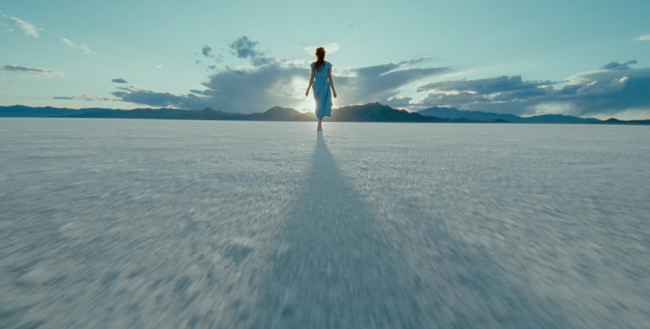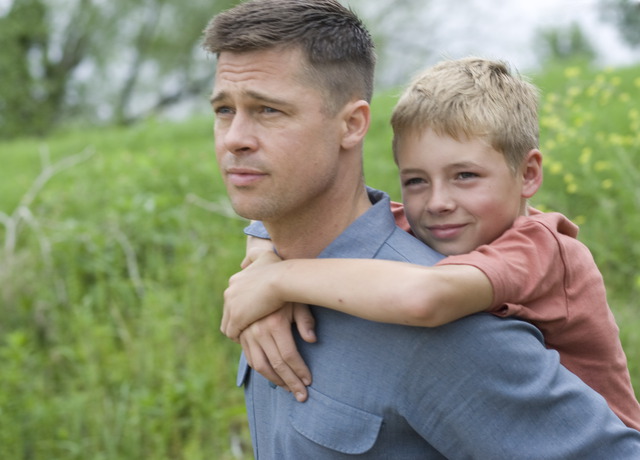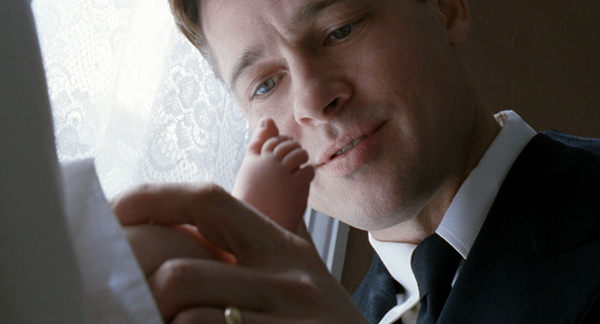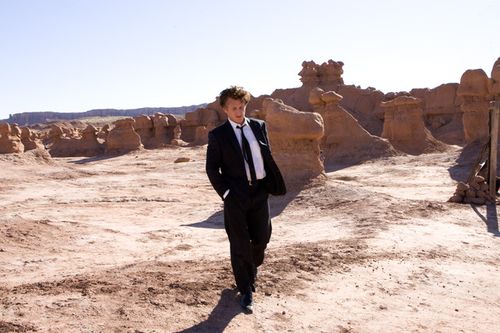Fri 27 May 2011
A Life (And Film) Less Ordinary
Posted by Ethan under Film Review, NYC Film Critic
[3] Comments
The Tree of Life
Written and Directed by Terrence Malick
Starring Brad Pitt, Jessica Chastain, Hunter McCracken, Sean Penn
****
Terrence Malick’s reclusive nature coupled with his infrequent forays into filmmaking guarantees that when he does make a movie, the anticipation level amongst his modest, but devoted fanbase will run high. Even by Malick’s standards though, the excitement surrounding the director’s fifth feature The Tree of Life has been particularly intense.
That’s largely because, until it premiered at the Cannes Film Festival last week, very little was known about what kind of a movie it was going to be, let alone what it was even about. Where the director’s last two films—1998’s The Thin Red Line and 2005’s The New World—were based on previously published material, Life was an original screenplay that was kept tightly under wraps during the movie’s almost four-year journey to the screen. (Shooting started in 2008 and, as is typically the case with Malick, the movie remained locked in the editing room for almost two solid years afterwards, while everyone close to the production was sworn to secrecy about its specific content.) During that time, a number of different rumors flew about what we might see when the opening credits finally rolled. There were going to be dinosaurs! Special effects sequences overseen by groundbreaking F/X wizard Douglas Trumbull! Brad Pitt with a ‘50s crew cut! With Malick’s camp generally refusing to confirm or deny these speculations, our imaginations ran wild picturing what the hell kind of a experience this mysterious moviemaker had in store for us this time.
Having now seen The Tree of Life, I can confirm that there are dinosaurs, impressive Trumbull-assisted effects sequences and Pitt sporting a crew cut. I’m also pleased to report that it is at once both the movie I hoped it might be and also completely unlike anything I could have expected. I could spend the rest of this review just reeling off adjectives for how I felt while watching it—surprised, frustrated, delighted, annoyed, enraptured, confused, awestruck. If nothing else, the sheer range of emotions the film inspires makes it tower above almost any other movie released so far this year. It’s a film that is guaranteed to elicit a strong response—both positive and negative—and that alone sets it apart from standard summer fare like Thor and Pirates of the Caribbean: On Stranger Tides, which only seek to (and, in my opinion anyway, fail to) deliver inoffensive, mechanical thrills that may send you home satiated, but not profoundly affected. Even if you come away hating The Tree of Life, you won’t forget the experience of watching it anytime soon.
In the interests of offering readers at least some idea of what they can expect from the movie, here’s the general gist of Life. The movie opens with a prologue (or, if you prefer, “overtureâ€) that introduces us to the O’Brien family, a tight-knit clan consisting of a father (Brad Pitt, in a very impressive performance), a mother (Jessica Chastain) and three young boys, including our hero Jack (Hunter McCracken). The time is the 1950s and the place is small-town Texas, a bucolic environment where Jack and his siblings can play outdoors late into the evening while their parents relax on the porch. Having given us a small peek at this idyllic existence, the film then jumps ahead several years to a time when the boys have grown up and moved away. One afternoon, there’s a knock on the front door and an older Mrs. O’Brien opens it to find a Western Union deliveryman clutching a telegram that carries bad news—one of their sons has died. In that instant, their world shatters and a profound sadness overwhelms them and their surviving offspring, including the now-grown Jack (Sean Penn), who now resides in the big city where he designs glass-encased skyscrapers for a living. Try as he might to move past his grief, his mind constantly returns to the same questions: why him and not me? Why must loved ones die? How can a world that has so much beauty in it also be so full of hurt and pain?
To address Jack’s concerns, Malick rewinds the clock some 14 billion years to the birth of our very galaxy. In a virtuoso twenty-minute sequence, we watch the Big Bang bring the Earth into being—a fiery ball of volcanoes and gas clouds that transforms over millions of years into a place capable of sustaining life. Tiny cells give way to larger organisms, which in turn evolve into various sea creatures and, eventually, giant land-dwelling lizards. Amidst all this new life, however, death is never very far away. One of the dinosaurs we glimpse is lying on a beach, its life ebbing away from the gaping wounds in its side. Later on, another reptilian predator approaches a downed dino, laying one clawed foot on its head. While it ultimately opts not to deliver the killing blow, this scene drives home (a bit too stridently to be honest) Malick’s overarching point that violence predates man.
Malick’s brief history of the beginning of time ends with an asteroid hurtling towards the planet’s surface, at which point he cuts back to the ‘50s and we go from one creation story to another—in this case, the creation of the O’Brien family. We watch Mr. and Mrs. O’Brien meet, marry and have Jack, whose childhood unfolds in a series of brief snapshots that almost feel as if they’ve been downloaded directly onto the screen from Malick’s own boyhood memories. (Indeed, The Tree of Life is suspected to be based directly on the director’s life story, not that he’d ever confirm or deny it in print.) In one moment, Jack is a newborn sleeping on his mother’s shoulder, in the next he’s happily sitting upright on the front lawn, and in the next he’s taking his first steps with his father’s help. At one point he stands uncertainly next to a bassinette, announcing the arrival of a baby brother. Presented without any kind of extraneous, expository narration or unnecessary time stamps, this sequence offers one of the most lyrical and deeply felt presentations of childhood I’ve ever seen onscreen.
Once Jack grows out of teething rings and diapers and into sneakers and stickball games, we settle into the movie proper, which largely revolves around his attempts to understand what it means to be a good and successful person. He certainly has contradictory models at home—Mrs. O’Brien is a gentle soul whose adoration for her children is absolute. Mr. O’Brien also loves the boys, but he’s a sterner presence in their lives. A former musician turned engineer (and amateur inventor), he’s the kind of person that obsesses over other people’s successes and his own failures, frequently telling Jack that nice guys often finish last in the big, bad real world. Sometimes his frustration boils over into outright anger and even flashes of violence; in one key scene, he teaches his kids how to defend themselves in a fight and blocks and parries their punches with a little too much ferocity. He’s not an evil man, but his flaws unnerve Jack, who is looking for guidance and reassurance that his father can’t provide. At one point, the boy confesses in a prayer that he doesn’t understand why he needs to be good when he knows that God is capable of—and indeed has done—wrong. Even though he’s seems to be asking this of the Heavenly Father, it’s clear that he’s actually addressing his own dad.
Meanwhile, back in the present day, the adult Jack still feels emotionally bereft. So Malick sends him on what is best described as a kind of spirit quest, one that takes him out of the real world and into a place—some may want to call it Heaven, although it lacks the typical elements we usually associate with that place, such as angels playing harps amongst fluffy clouds—where he comes face-to-face with all the people from his childhood, including his mother, father and even his younger self. He also sees his brother and bids him farewell, as his mother’s spirit appears to offer her child’s memory up to the universe. And with that, he reawakens in his Earth-bound body and seems noticeably healed. The film’s enigmatic final shot is of a bird soaring through the skies next to a bridge, perhaps representing the link between this world and the one that Jack briefly visited. Or maybe Malick and his DP Emmanuel Lubezki (who did such brilliant work on The New World) just really liked how that bridge looked at magic hour.
I’ve essentially described the general outline of The Tree of Life, but I haven’t at all spoiled the experience of actually watching it.  That’s due to Malick’s unique filmmaking style, which he’s developed and honed over the course of his five features to date. If you’ve seen any of his previous movies, you already know that he doesn’t construct them in conventional ways. Oftentimes viewers are dropped into the middle of scenes (apparently Malick shoots his films very much the same way, rarely having the actors start from the top of a scene) and dialogue is stripped back to a bare minimum, replaced by voiceover musings or bursts of classical music. The director also employs an impressionistic rather than a strictly chronological editing scheme; he matches scenes based on thematic, emotional and visual cues rather than purely narrative beats. In this way, The Tree of Life demands a level of attention and engagement that fewer and fewer films—at least on the studio level—strive to achieve. Too many blockbusters (and independent films for that matter) are pre-programmed to tell the audience what to think and how to feel; Malick allows viewers to make up their own minds, even if all they come away feeling is frustration or boredom.
Formally, The Tree of Life is similar to Malick’s past efforts, but the director is also exploring some new terrain here. For starters, the movie is suffused with a feeling of what I’m choosing to call atheistic spirituality. While many of his previous movies have carried a spiritual edge, this one is the first that could be described as a religious film. What’s fascinating is the way Malick grounds the film’s spiritualism in decidedly real-world terms. For example, the creation sequence shows us Earth, as the Good Book puts it, “without form and void†but then depicts its gradual transformation into a place capable of sustaining life as the result of various scientific and biological processes, rather than the whims of a higher power.  (Along those same lines, it’s interesting to note that in this creation story, the first victim isn’t Abel, but rather that wounded dinosaur on the beach.) This section of the film is also unique in the director’s oeuvre in that it requires him to depict nature’s fury as well as its exquisite beauty. Malick’s fascination with the natural world is well known—aside from being one of the things his critics most commonly complain about, it’s also the aspect of his filmmaking style most ripe for parody. His movies can be viewed as extended rhapsodies to nature; indeed, they often seem to posit mankind as the fatally flawed creatures responsible for ruining what would otherwise be an idyllic Eden. Here though, there’s an acknowledgement that beauty and danger exist hand-in-hand in our environment and have since the dawn of time.  Â
The Tree of Life distinguishes itself from the rest of Malick’s filmography in other ways as well. As previously mentioned, it feels like the director’s most personal movie to date, although we’ll probably never really know how much of the movie is autobiographical unless Malick suddenly decides to start giving interviews again. It also marks the first time he’s filmed a contemporary urban landscape, as all of his previous pictures have been period pieces set in rural environments. The scenes of the adult Jack wandering through an unspecified city (actually downtown Austin) are strikingly photographed, with Malick’s camera framing all of the towering skyscrapers from below, making them resemble trees carved out of glass and steel. The effect is disorienting after awhile, which effectively places you inside the uneasy mind of a man overwhelmed by sadness. (It’s a shame that Penn isn’t given more to do than look glum, but l’m also glad that Malick opted not to belabor these sequences, which generally lack the resonance of the ’50s material.)
To be perfectly honest, I’m not sure that I completely buy into the movie’s various philosophies on life, death and letting go of grief. But I don’t think he expects or even wants to convert every single audience member to his way of thinking. Rather The Tree of Life is one man’s rumination on these larger questions that is meant to be accepted and analyzed as suggestion rather than doctrine. More than anything it’s a beautifully realized piece of direction that employs the tools and language of cinema in ways that constantly surprise, challenge and (in my case, at least) delight the viewer. Many movies fade from your mind the minute you leave the theater; The Tree of Life one of the few that, if you let it, will take root and grow.             Â
The Tree of Life opens in limited release today.





While I appreciate the lengthy review, I think you really did a disservice to your readers (myself included) by ruining the final shot. I get the impression that you think this movie is kind of unspoilable (eg “I haven’t at all spoiled the experience of actually watching it”), but you spoiled something for me that I consider to be really important. This coming from a Malick obsessive who’s read a huge number of reviews of this and has yet to come across any spoilers that have really bothered me. So I’d maybe excise that spoiler from your review. Just a suggestion.
I’m sorry you feel that way, but as you said, I don’t think this movie can be spoiled in the conventional sense since so much of it is in how the audience chooses to interpret it. Simply describing the last shot ultimately reveals very little beyond what I think Malick might be attempting to say. You may see it in the context of the movie and come away with an entirely different interpretation. Beyond that, I felt that if any movie deserved to be discussed in more detail, this one merited it. I personally didn’t feel I could adequately describe my feelings about the movie without mentioning things like the last shot. So again, apologies if you were taken aback, but I wouldn’t worry about the experience being somehow ruined. The last shot is simply one more piece a beautiful tapestry Malick was woven. Thanks for your comment and I hope you like the film.
Thanks for the thoughtful reply. I hear where you’re coming from, and I’m not really all that bummed about it anymore. Anyway, thanks again for the lengthy review. I’ve never been more excited to see a movie in my entire life.